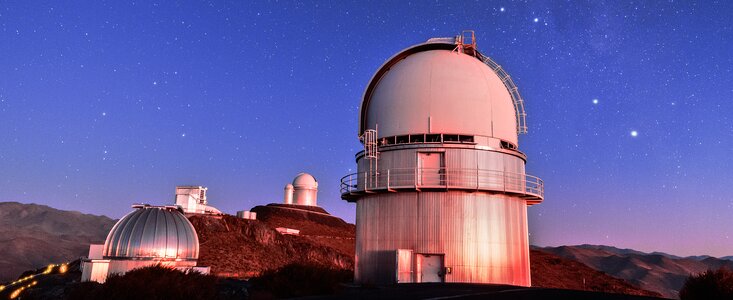Danish Involvement with the European Southern Observatory

Photograph showing several telescopes at La Silla Observatory, with the Danish 1.54-metre telescope in the foreground. Credit: Sangku Kim/ESO
Denmark joined ESO as a Member State on 24 August 1967. Ever since, the Danish scientific community has been involved in significant discoveries made with ESO telescopes and Danish institutions and industry have contributed to the development of instruments and telescopes.
Denmark currently contributes 1.93% of ESO’s revenue (2021 contribution), worth 3 706 000 EUR.
As of mid 2022, there are seven Danish nationals employed at ESO, six in Germany and one in Chile. Furthermore, ESO has awarded five studentships and nine fellowships to Danish nationals since 2004.
Denmark is represented in the various ESO governing and advisory bodies by astronomers and policy experts; the current Danish representatives of ESO’s various committees with national representation can be found here.
The ESO Science Outreach Network (ESON) includes Danish representatives who act as ESO’s media and outreach local contacts.
Here follows some information about Danish involvement with ESO.
Discoveries by Danish-based astronomers using ESO telescopes
Danish astronomers and astronomers working at Danish institutes were involved in the many scientific discoveries done with ESO telescopes. For example:
- Following the merger of two neutron stars in 2017, a team led by Darach Watson from the University of Copenhagen pointed the X-shooter instrument on ESO’s Very Large Telescope (VLT) towards the newly formed kilonova. They found heavy elements born from this collision, a key discovery in understanding the origin of elements.
- Giorgos Leloudas at the Niels Bohr Institute, University of Copenhagen, led a team that used several ESO telescopes to study a bright flash, initially thought to be the brightest supernova ever seen, and discovered that it was probably produced by a star being swallowed by a black hole.
- Using X-shooter in combination with ALMA Darach Watson (University of Copenhagen) observed one of the most distant galaxies ever, providing tantalising evidence for the rapid evolution of galaxies after the Big Bang.
- Christa Gall (Aarhus University, Denmark) and Jens Hjorth (Dark Cosmology Centre, University of Copenhagen) were part of a team that used the VLT to follow stardust being made in real time during the aftermath of a supernova explosion.
Danish involvement in ESO instruments and telescopes at ESO sites
Denmark is contributing to many aspects of ESO, with Danish institutions behind already existing and upcoming instruments based at telescopes on ESO sites. These include:
- The Danish 1.54-metre telescope, situated at ESO’s La Silla Observatory, which can produce impressive images, and has allowed astronomers to make several first discoveries. The telescope has hosted many instruments, such as CORAVEL, DFOSC and the Hβ Photometer, all produced in collaboration with the University of Copenhagen.
- The X-shooter instrument, a joint project by Denmark, France, Italy, the Netherlands and ESO, which has been used extensively at the VLT to, for example, study the afterglow of gamma-ray bursts and the formation of heavy elements in the very early Universe. The collaborating institutes in Denmark are the Niels Bohr and the DARK Institutes of the University of Copenhagen and the National Space Institute (Technical University of Denmark).
- The successor of X-shooter, SOXS, which will be installed at the 3.5-metre New Technology Telescope (NTT) at ESO’s La Silla Observatory and will observe transient objects, such as gamma-ray bursts and supernovae. The Niels Bohr Institute has participated in the development of this instrument.
- The FEROS spectrograph at the MPG/ESO 2.2-metre telescope, which has been built by a consortium where the Astronomical Observatory Copenhagen participates. FEROS can collect high-resolution data in wavelengths from near-ultraviolet to infrared, covering the entire visible spectrum.
Danish involvement in ELT instruments
In 2013, Denmark confirmed its participation in ESO’s upcoming Extremely Large Telescope (ELT). The country will contribute to many aspects of the telescope, including the development of ANDES, the ELT instrument that will study astronomical objects with unprecedented sensitivity. The Niels Bohr Institute at Aarhus University participates in the consortium that is developing ANDES.
Danish industry and technology contributions to ESO
Danish industry has been awarded significant contracts by ESO. For example, Terma A/S, a global company with Danish roots, has been awarded multiple contracts for IT service provision. Denmark’s Polyteknik AS was contracted to overhaul the 8m-mirror-coating plant at ESO’s Paranal Observatory.
Danish industry contributions to the ELT
Danish companies have also been awarded significant contracts related to ESO’s ELT, including
- Ramboll: for consulting services during the procurement for the ELT dome and main structure.
- Force Technology: awarded two contracts related to the ELT wavefront real-time computer.
- IPU: did the process study of the ELT protected silver coating removal.
- Kirkholm Maskiningeniorer A/S: worked on the conceptual design of the ELT prefocal station.